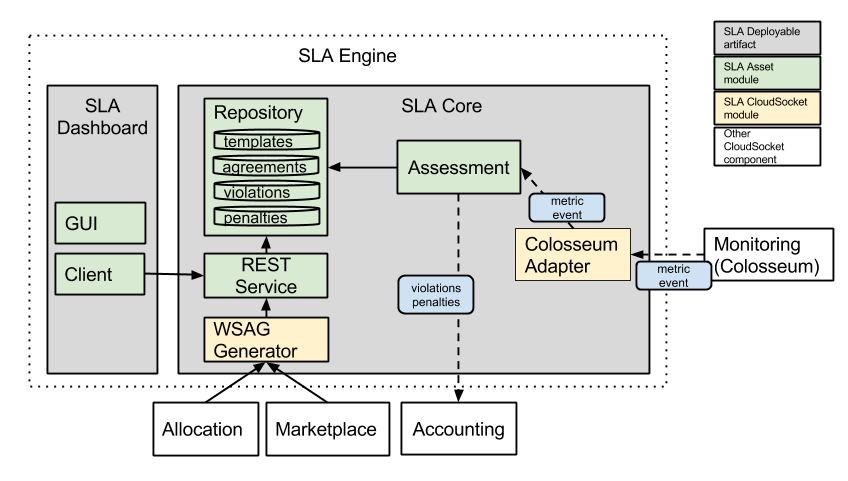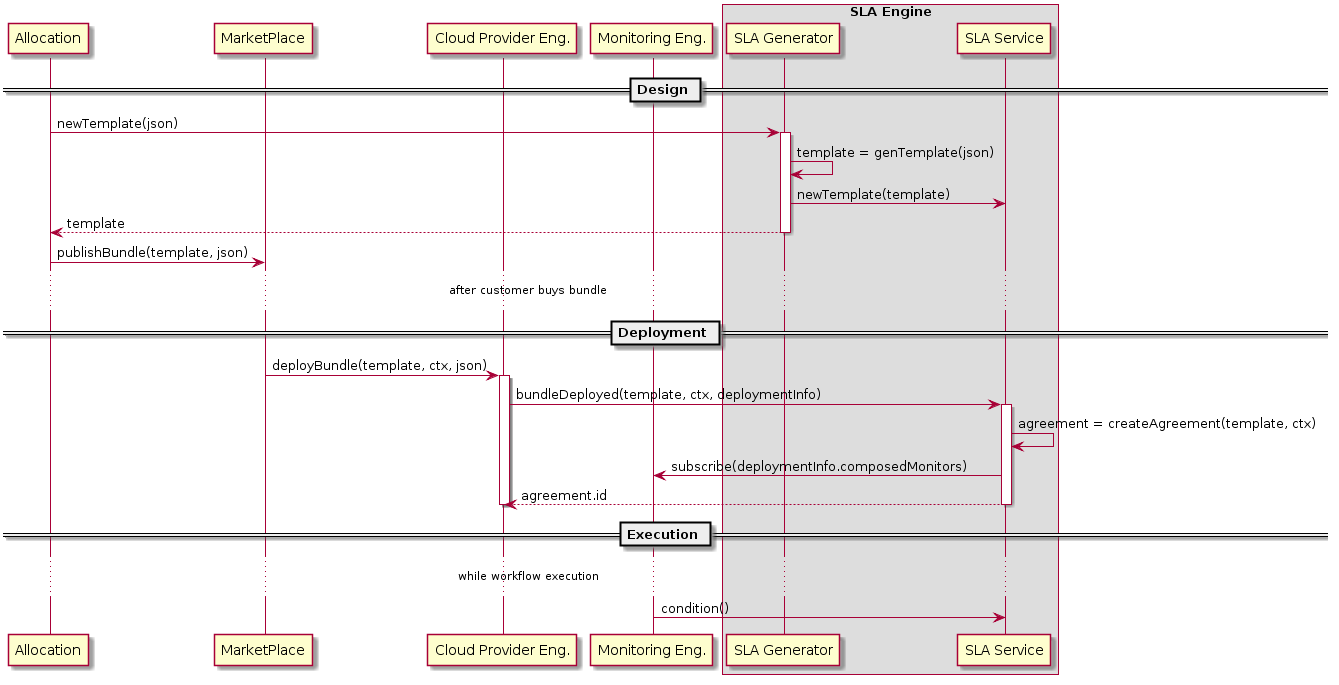SLA Engine Component
Summary
The SLA Engine represents the component responsible for generating, storing and observing the formal documents describing electronic agreements between the parties involved in CloudSocket: BPaaS bundle customers, brokers and cloud providers. The component follows the WS-Agreement specification. This means that the documents representing templates and agreements are valid according to the schema defined in the specification. The specification is extended where needed to cover some specific CloudSocket needs.
This component will expose:
- A graphical user interface for checking the status of agreements,
- A REST API interface allowing programmatic access to the different types of functionalities offered.
The main functionalities are:
- Generation of WS-Agreement templates and agreements.
- Management of SLA related entities: templates, agreements, providers, violations, penalties
- Assessment of SLOs and corresponding penalties when an SLO is violated.
- Notification of detected violations and incurred penalties to interested parties.
- ...
| Type of ownership | Extension & Adaptation |
| Original tool | SLA Framework asset |
| Planned OS license | Apache License Version 2.0. |
| Reference community | None |
Consist of
- SLA Engine (core functionalities)
- SLA Dashboard (Graphical User Interface)
- SLA Generator (generates WS-Agreement compliant documents)
Depends on (uses or used-by dependencies)
- Monitoring Engine
- Allocation Environment
- Marketplace
- Cloud Provider Engine
Component responsible
| Developer | Company | |
|---|---|---|
| Roman Sosa Gonzalez | roman.sosa@atos.net | Atos |
| Joaquin Iranzo | Joaquin.iranzo@atos.net | Atos |
Architecture design

Figure: General architecture for SLA Engine
The SLA Engine in CloudSocket is composed of three main components:
- SLA Core. It relies on the Atos SLA Framework asset, with some CloudSocket-related modules. It contains all the basic functionality. The main subcomponents are:
- Repository. Database of WSAG related entities.
- Assessment. It is in charge of the evaluation process of the SLA agreements. It notifies raised violations and penalties to interested observers (i.e., an Accounting component).
- REST Service. It is the REST interface of the SLA Core to the world.
- WSAG Generator. It generates WSAG-compliant templates and agreements according to the requirements of allocation and marketplace, respectively.
- Colosseum Adapter. It is charge of: i) subscribing into Colosseum to the appropriate metric events, and ii) to receive events and translate them into the internal SLA representation.
- SLA Dashboard. This component is a frontend application where the user/admin can check the status of agreements and the penalties that have been applied.
The related components with the SLA Engine in CloudSocket are:
- Monitoring. It reports the metric data to the SLA Core.
- Allocation. The Allocation Environment contacts the SLA Generator to obtain a template that describes the service level of a BPaaS Bundle.
- Marketplace. It shows a human-readable description of a BPaaS Bundle SLA to the customers.
- Cloud Provider Engine. It pProvides the SLA to be stored and managed by the SLA Engine.
Installation manual
Development
Requirements
- Oracle JDK >= 1.7
- Database to install the database schema for the service: Mysql>=5.0
- Maven >= 3.2
- Python >=2.7
Installation
- Download source code from gitlab
git clone https://omi-gitlab.e-technik.uni-ulm.de/cloudsocket/sla-framework.git cd sla-framework
- Create database in mysql
$ mysql -p -u root mysql> CREATE DATABASE atossla; mysql> CREATE USER atossla@localhost IDENTIFIED BY '_atossla_'; mysql> GRANT ALL PRIVILEGES ON atossla.* TO atossla@localhost;
- Compile SLA Engine
( cd sla-core && mvn clean install )
- Execute sla-core server. The following command will start an SLA Engine server in port 8080.
sla-core/bin/runserver.sh [port]
- Execute sla-dashboard server. The following commando will start an SLA Dashboard server in port 8000
sla-dashboard/bin/runserver.sh
Production
Requirements
- Oracle JRE >= 1.7
- Database to install the database schema for the service: Mysql>=5.0
- Python 2.7
- Virtualenv
Installation
Create the database like done in Development section.
The script `dist/bin/make-dist.sh` creates an archive file with the necessary scripts and artifacts to run the SLA Engine in a server.
dist/bin/make-dist.sh scp dist/target/sla-framework.tar.gz server: # replace 'server' with the ip/name of server ssh server: tar xzf sla-framework.tar.gz cd sla-framework virtualenv ~/virtualenvs/sla-dashboard ( . ~/virtualenvs/sla-dashboard/bin/activate && cd lib/sla-dashboard && pip install -r requirements.txt && ./manage.py migrate ) bin/start-sla-core-service.sh bin/start-sla-generator-service.sh bin/start-sla-dashboard-service.sh
To stop the services:
bin/stop-sla-core-service.sh bin/stop-sla-generator-service.sh bin/stop-sla-dashboard-service.sh
Environment variables
The SLA Engine execution can be configured with the use of environment variables. The list of recognized env vars and their default values is:
SLA_CORE_HOST (127.0.0.1), SLA_CORE_PORT (8080): sla-core listening address; passed to sla-dasboard.SLA_DASHBOARD_HOST (127.0.0.1). public hostname of SLA Dashboard; it must be reached by IDM component.SLA_DASHBOARD_PORT (8000): sla-dashboard listening port.SLA_GENERATOR_HOST (127.0.0.1), SLA_GENERATOR_PORT: sla-generator listening address.DB_URL (jdbc:mysql://localhost:3306/atossla): A jdbc connection string in the formatjdbc:mysql://${IP}:${PORT}/${DB}.CLOUDIATOR_URL (http://127.0.0.1:9000/api): URL of Cloudiator REST API.SLA_URL (http://127.0.0.1:8080/api): Public address of SLA Engine REST API; used in subscriptions to Monitoring Engine in order to receive metric notifications.IDM_CLIENT_ID (""): SLA Engine Client ID for OAuth2 authorization flow.IDM_CLIENT_SECRET (""): SLA Engine secret for OAuth2 authorization flow.IDM_AUTHORIZE_URL (http://csmarket.ymens.com:9090/oauth/authorize): Authorization URL in OAuth2 authorization flow.IDM_TOKEN_URL (http://csmarket.ymens.com:9090/oauth/token): Token URL in OAuth2 authorization flow.
User manual
API Specification
The generic API is in SLA Framework API.
The lifecycle of the SLA in CloudSocket is shown in the diagram below. 
Figure: SLA Sequence Diagram
Specific CloudSocket API is explained below:
Generate a template
POST /api/templates
This endpoint takes a simplified JSON definition of a WS-Agreement template and returns the WS-Agreement template, which can be fed into the SLA Core.
An input example: JSON Input for Christmas bundle
The penalties element are described in the SLA Core developer guide (search for Business Rules).
Example:
curl -X POST http://134.60.64.232:8001/api/templates -d@./cs-wsag-generator-service/src/test/resources/json_christmas.json -H"Content-type:application/json"
The input file is:
{
"templateName" : "Sending Christmas Greetings (with SLA) SLA Template",
"bpaasBundle" : "Sending Christmas Greetings (with SLA)",
"broker" : "bwcon",
"assessment" : "bwcon",
"monitoring" : "bwcon",
"guaranteeTerms" : [ {
"name" : "KPI Hourly CPU_GuaranteeTerm",
"sloDescription" : "Hourly Usage of CPU should be less than 80%",
"penaltiesDescription" : "3 penalties occurs in one day => 1€ discount on the current month",
"slo" : {
"condition" : "KPIHourlyCPU",
"context" : "MeanCPU",
"comparison" : "LE",
"threshold" : 80.0
},
"penalties" : [ {
"count" : 3,
"interval" : "P1D",
"penalty" : {
"type" : "discount",
"expression" : "1.00",
"unit" : "euros",
"validity" : "P1M"
}
} ]
} ]
}
The output is:
<?xml version="1.0" encoding="UTF-8" standalone="yes"?>
<wsag:Template xmlns:cs="http://wsag.sla.cloudsocket.eu" xmlns:sla="http://sla.atos.eu" xmlns:wsag="http://www.ggf.org/namespaces/ws-agreement" wsag:TemplateId="3b4d79ba-307f-40aa-a139-b925efe1149d">
<wsag:Name>Sending Christmas Greetings (with SLA) SLA Template</wsag:Name>
<wsag:Context>
<wsag:AgreementResponder>bwcon</wsag:AgreementResponder>
<wsag:ServiceProvider>AgreementResponder</wsag:ServiceProvider>
<sla:Service>Sending Christmas Greetings (with SLA)</sla:Service>
<cs:context>
<cs:assessment>bwcon</cs:assessment>
<cs:monitoring>bwcon</cs:monitoring>
</cs:context>
</wsag:Context>
<wsag:Terms>
<wsag:All>
<wsag:GuaranteeTerm wsag:Name="KPI Hourly CPU_GuaranteeTerm">
<wsag:ServiceLevelObjective>
<wsag:KPITarget>
<wsag:KPIName>KPI Hourly CPU_GuaranteeTerm_kpi</wsag:KPIName>
<wsag:CustomServiceLevel>
<cs:slo>
<cs:constraint>MeanCPU LE 80.000000</cs:constraint>
<cs:conditionConstraint>KPIHourlyCPU NOT EXISTS</cs:conditionConstraint>
<cs:description>Hourly Usage of CPU should be less than 80%</cs:description>
</cs:slo>
</wsag:CustomServiceLevel>
</wsag:KPITarget>
</wsag:ServiceLevelObjective>
<wsag:BusinessValueList>
<wsag:CustomBusinessValue count="3" duration="P1D">
<sla:Penalty type="discount" expression="1.00" unit="euros" validity="P1M"/>
<sla:description>3 penalties occurs in one day => 10€ discount on the current month</sla:description>
</wsag:CustomBusinessValue>
</wsag:BusinessValueList>
</wsag:GuaranteeTerm>
</wsag:All>
</wsag:Terms>
</wsag:Template>
The CloudSocket sequence diagram is depicted in figure.
Generate an agreement
POST /cloudsocket/api/agreements
This endpoint generates an agreement from a template and the needed information context. It is intended to be called when a bundle has been deployed. Both provider (if not yet), template (if not yet) and agreement are stored in SLA Core.
It receives the template in the body, and the context information (currently, only the customer ID) in headers.
Headers:
- customer ID: X-CloudSocket-Customer
Example:
curl -X POST -d@sla-service/src/test/resources/samples/template02.xml -H"X-CloudSocket-Customer: customer-a" http://134.60.64.232:8080/cloudsocket/api/agreements -H"Content-type:application/xml"
Input body: Template
X-CloudSocket-Customer header: customer-a
The output is:
4679e474-2322-4da2-be75-a0004c7f8df8
Start evaluation
PUT /cloudsocket/api/enforcements/{agreementId}
This endpoint makes the appropriate subscriptions to the Monitoring Engine and starts the evaluation of the agreement. It is intended to be called just after the CreateAgreement endpoint.
The body contains a CsEnforcementJob. A serialized example is found in https://omi-gitlab.e-technik.uni-ulm.de/cloudsocket/sla-framework/blob/master/sla-core/sla-service/src/test/resources/samples/cs-enforcementjob2.json
It returns the enforcement entity in /api/enforcements/{agreementid} in the body.
Example:
curl -X PUT -d@sla-service/src/test/resources/samples/cs-enforcementjob2.json http://localhost:8080/cloudsocket/api/enforcements/agreement-id -H"Content-type:application/json" -H"Accept:application/json"
Input body:
{
"agreementId" : "agreement-id",
"enabled" : true,
"composedMonitorIds" : [ 1, 2, 3 ]
}
Output:
{"agreementId":"agreement-id","enabled":true}


